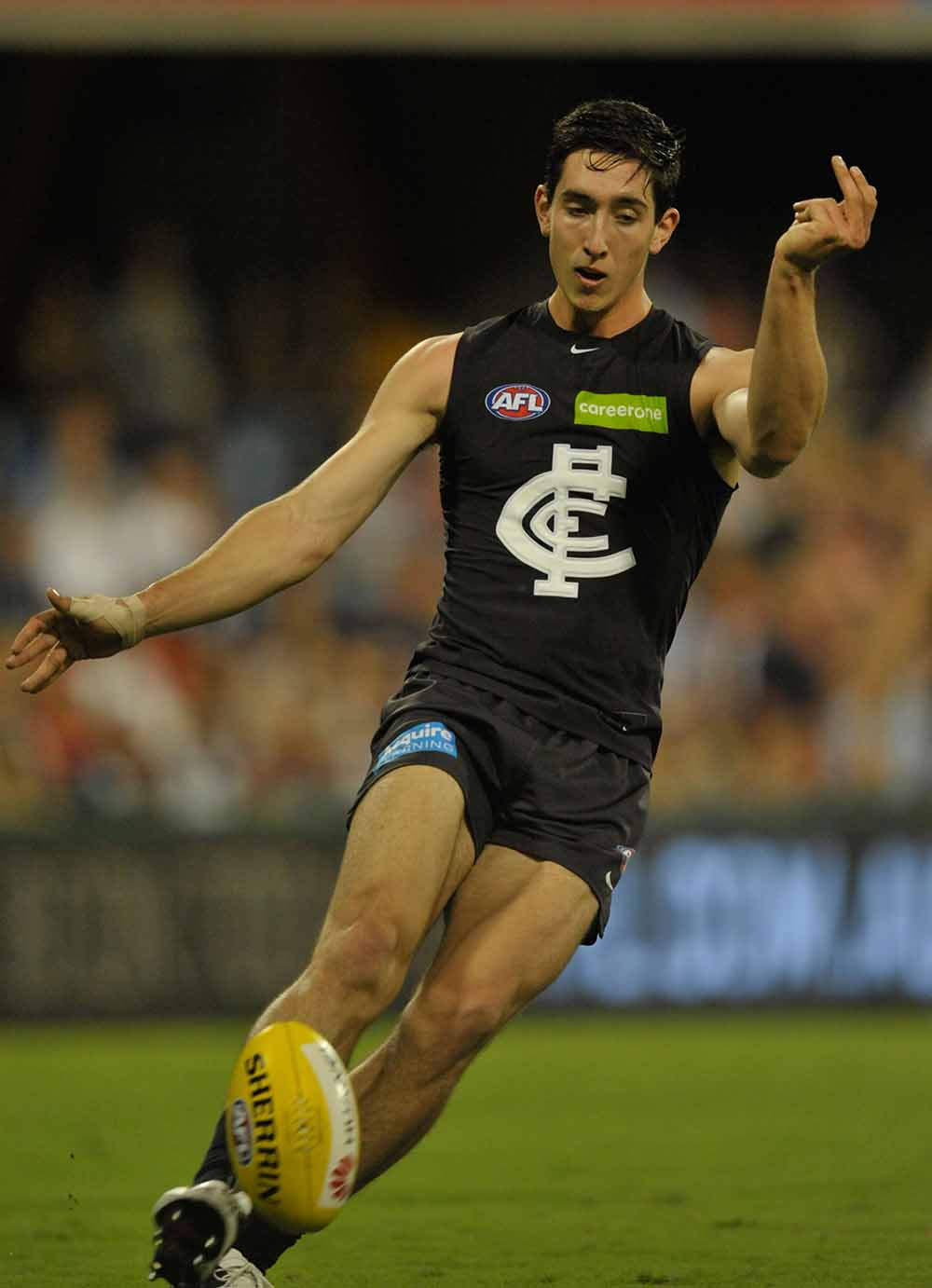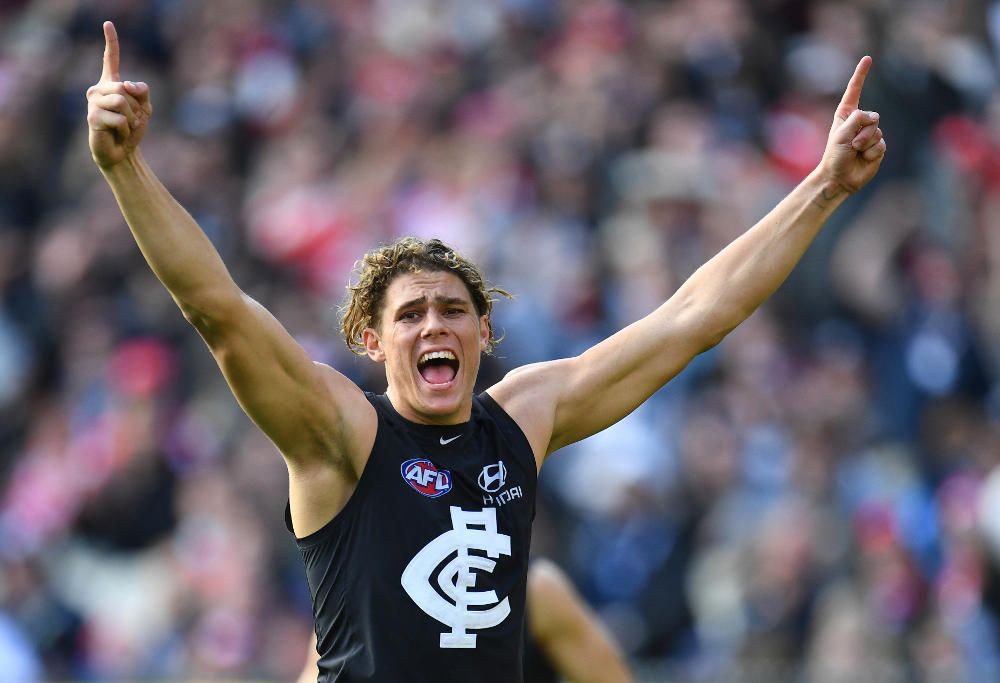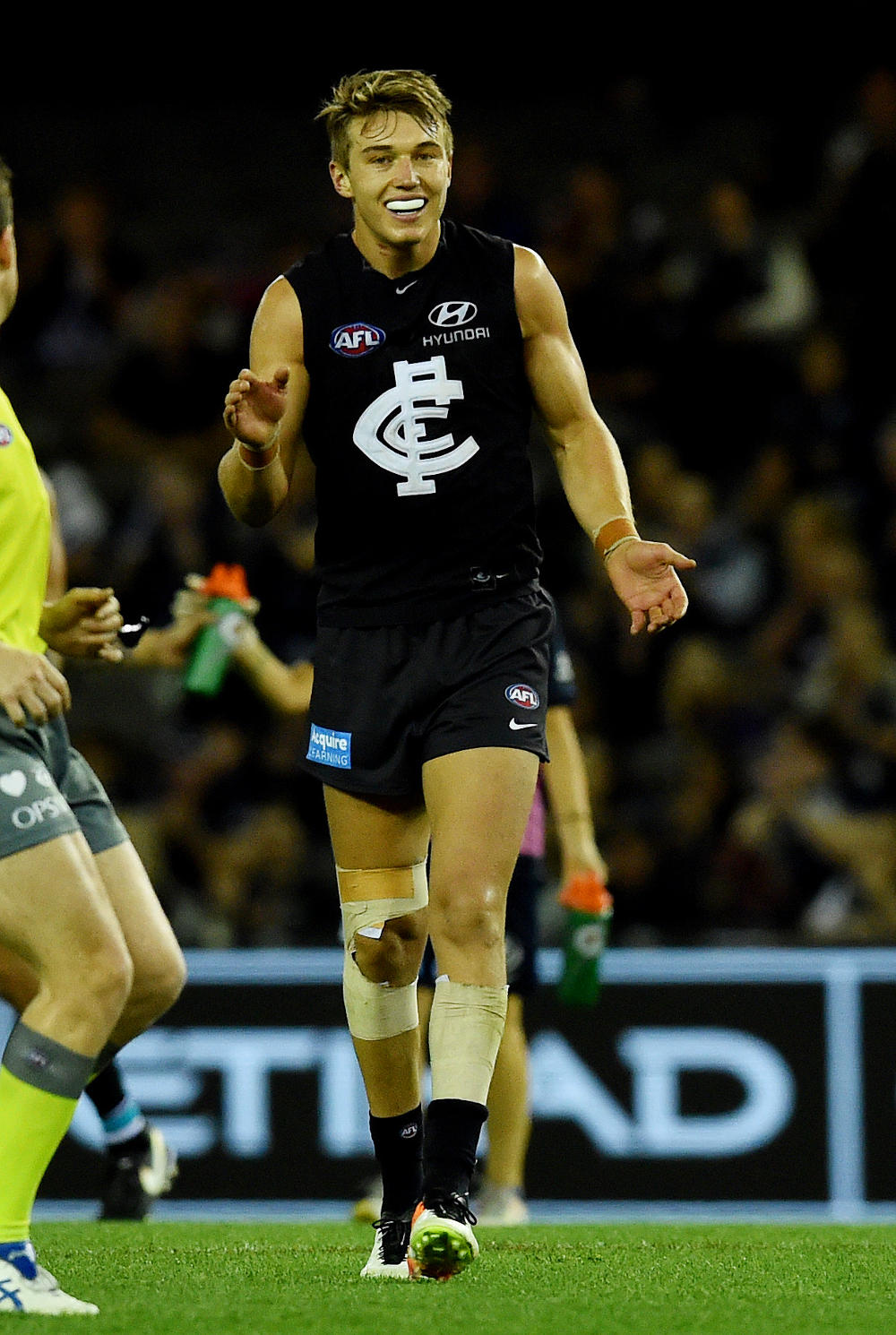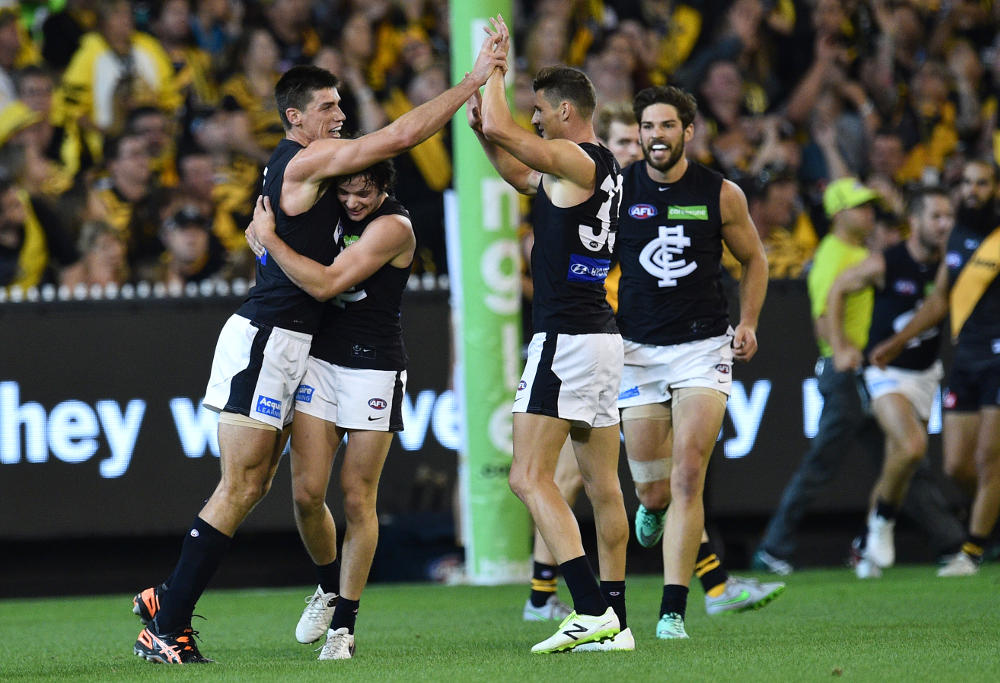I’ve been mean to Carlton a lot in recent years. It’s time to change tact.
The Blues, building from a very low base, are progressing nicely, and a stable platform has been established. There is work to be done, but with five wins in the bank, plenty is going right.
After knocking off Greater Western Sydney and Gold Coast in consecutive weeks, Carlton have five wins in season 2017. They have joined the cavalcade of teams that sit within a game and percentage of eighth spot on the ladder, hitching their wagon to the hope of finals contention that has captured almost the entire competition.
The Blues won’t make it into the final eight. They were never going to this year, and nor should they have had that ambition. Carlton are two years into a demo job, a list rebuild so extensive that you’ll barely notice the timber frame in place is an original. This isn’t news to anyone – from the time Carlton removed Mick Malthouse as coach to now, every decision has been framed in terms of how it gets the Blues back to contention.
Last weekend’s victory against the Suns was a peer taking out a peer. Their win against the Giants was not. Surprise games have come from all kinds of strange places this year, and that was one of them. That’s not to say Carlton were an undeserving winner – anything but. While GWS had plenty of territory, and enough time in possession to kick a winning score, they were sloppy. And the Blues had the game to make them pay.
That win provided ample insight into the platform Carlton and its head coach Brendon Bolton are building. These were confirmed against the Suns and Tigers in the past two weekends – even if a win was not forthcoming against Richmond. Indeed, there’s an argument the Blues have reached their nadir and the only way from here is up.
It is true. To a point. Carlton has established a solid foundation, re-casting its football identity in the process. But it is not time to celebrate the resurrection quite yet.
The House of Bolton
Carlton’s best asset is its coach, Alastair Clarkson Coaching Academy honours graduate Brendon Bolton. Lauded or criticised for being a ‘non-football person’ (depending on your intellectual capacity), Bolton has turned a list of questionable pedigree on past performance into one of the most sturdy, predictably honest, and hardworking units in the competition.
It hasn’t all been smooth; it took some time for segments of the Carlton fanbase to work out what they had got themselves into. A 90-point decimation at the hands of Port Adelaide in Round 5 was a testing time, internet boards – the font of football hot takes – openly questioned both Bolton and the team’s youth-first selection policy.
The harsh reaction was no doubt driven by the team’s generally languid start to the year – coming in, the Blues were 1-3 with the lone victory against Essendon in monsoonal conditions.
Since that evening, the Blues have reeled off four wins from nine games, looking far more assured behind the ball. Indeed, it was the first and last time Carlton has been blown out in 2017. Bolton keeps things simple for his charges: play your man, help if you can, and don’t give up silly turnovers trying to take the game on.
It has manifested in a stellar-under-the-circumstances outcome for the Blues on defence. Through Round 14, Carlton are the tenth ranked defence in the competition, conceding 88.5 points per game for a Defensive Efficiency Rating of +2.5. This is a slight improvement on their 2016 performance in terms of points per game (89.9, ranked 10th), but a sizeable lift in their relative performance against the competition (their DER in 2016 was -1.3).
Carlton are doing this in spite of a relative young and/or maligned set of key position players.
Jacob Weitering (who now appears to have settled in defence after starting the year in the forward 50) and Caleb Marchbank are one of the youngest key position duos in the league. Sam Rowe knows how to spoil and that’s about it, while Alex Silvagni knows how to get in the way of opposition forwards and that’s about it. Lachie Plowman has been solid, and clearly has the backing of the coaching staff given he has played all 13 games this season.

AAP Image/Josh Pryke
Liam Jones has come out of nowhere to emerge as a viable third tall overlapping defender. In a year where nothing makes sense, of course the forgotten Jones returns to the league after playing 17 of a possible 54 games to star as a leaping, intercepting defender. Of course.
Bolton has chopped and changed, tinkering with his back 50 for reasons only he and a select group at Carlton know. Yet the Blues are still performing well on defence – why? It’s all about scheme.
Carlton are leading the league in stopping opponents from getting inside 50 when they have possession of the ball. The Blues are leaders in keeping the ball out of dangerous areas of the ground, playing a kick-heavy possession oriented game that allows their defenders time to set up behind the ball.
The Blues have a remarkable aversion to handballing; they have as a collective handballed the ball just 135 times a game in 2017, almost 40 below the league average.
Instead, they kick. Carlton’s kick to handball ratio on the season is 1.69, way higher than the league average of 1.23 and a remarkable 67 basis points above the handball-happy Western Bulldogs.
It’s all about conservative retention of possession. Carlton average about two extra minutes of possession per game than their opponents, and in losses this only dips to -2.2 minutes of possession – the third best mark in the league behind Collingwood (-1.9) and Melbourne (+0.5).
By slowing the pace of the game, Bolton’s team is able to stay level-headed, organise itself, and choke up the fast-break football which has become the go-to for so many teams in 2017.
This scheme also allows for Carlton’s two biggest weapons, Sam Docherty and Kade Simpson, to patrol the backline and provide help to the taller, more accountable defenders on a very regular basis.
The indefatigable Simpson is averaging a career high 7.5 marks per game, and is third at the Blues with 394 metres gained per game.

AAP Image/Mal Fairclough
Docherty is on another level all together, putting up an Alex Rance-like 9.8 marks per game, averaging 28 disposals, (21 of them kicks) and gaining an enormous 531 metres. His 6.2 intercepts aren’t quite of the level of the primo defenders in the league, but his is something of a unique role.
Bolton places a lot of trust in these two men to keep the youthful back 50 under control. They are doing a very good job.
Of course, like anything in Australian rules football, it only works most of the time. Carlton still have a tendency to be opened up on turnovers when they make a mistake – like all teams bar the top handful. They also turn the ball over at a fairly regular clip, which statistically is likely a product of their tendency to kick rather than handball.
Carlton’s opponents tend to find it relatively easy to generate inside 50s: they get about seven per cent more on average per minute of possession (which translates to just under four extra inside 50s per game than the average).
In reviewing the tape, Carlton don’t appear to press up the ground like most other teams when they get the ball inside 50. Bolton’s conservative approach is more about stopping the ball in transition rather than stopping the transition opportunity itself. That has its risks – Port Adelaide subscribe to the ultra-heavy press, and only allow their opponents 49 inside 50 entries per game – but also its advantages.
The coach is playing the long game. His scheme centres on the need for his players to be accountable to their opponents, likely in an effort to see them improve by learning how to win one on one. Docherty and Simpson are there to provide support, but it is up to Weitering, Marchbank, Plowman and those who come after them to increasingly shoulder the load.
Fortunately, Bolton’s house has a solid foundation, and it is a significant endorsement of his method, scheme and philosophy. You could set your watch to a Carlton defensive performance; simple and reliable. This does not extend to the other end of the ground.
What’s the opposite of good?
We know all of Carlton’s discretionary coaching and development effort has been pumped into the defensive side of the team’s game. How? Carlton are an abysmal offensive team.
There is no flow, no continuity, no dare. This is partly by design of course, as we’ve just discussed at reasonable length above. But if football is ultimately simple points for less points against equation, Carlton need significant help improving the former.
The Blues are scoring 72.3 points per game, ranked 18th in the competition. Their Offensive Efficiency Rating of -20.3 puts them in rarefied air – only six non-expansion teams have recorded an OER of worse than -20 since the year 2000. Importantly, it is a relative deterioration from last season, given the slight improvement to overall league scoring in 2017.
There are four teams that average less than 50 inside 50 entries in 2017: Brisbane (46.5), Carlton (46.4), Fremantle (46.7) and Hawthorn (46.5). Carlton is the only team that does so while recording at least 50 minutes of possession per game (51.2 minutes) – the other teams are all below 50. It hints at the lack of transition.
This is okay for now, although the extent to which scoring has been troublesome for the Blues for all of 2017 should at least be on Bolton’s whiteboard. Carlton is the only team in the league without a 100-point game to its name this season, an arbitrary marker, but an important one in the football punditry world.
The most interesting part of this puzzle is the likely need for further turnover on Carlton’s list as it more broadly is positioned to contend in the years ahead. Depending on your perspective on the time it will take for the Blues to push for finals – more on this in a moment – it’s quite possible that just Jarrod Pickett, Jack Silvagni (whose play has been very good in the past month), Charlie Curnow and Sam Petrevski-Seton could be the only attacking players currently plying their trade for the Blues still on the list.

AAP Image/Julian Smith
Again, this depends on your point of view on the timing of a Blue September, but it is likely Dale Thomas (30 years old in Round 1 2018), Matthew Wright (28) and Levi Casboult (28) will be at the tail end of their careers or already on the pine. Rhys Palmer, who has only played one game, will be 29 next year. There’s still some work to do on this front.
Time to be bold
Which brings us to the inevitable question: how far are Carlton away from leaving base camp and climbing the mountain once again?
Two weekends ago, there was plenty of chatter that the Blues were ready to go. Defensively, perhaps yes, although being ranked tenth in the league means you’re only average. Offensively, absolutely not. One area we haven’t touched on is the midfield, which I’ve deliberately saved for last.
Carlton’s trio of number one draft picks, Marc Murphy, Bryce Gibbs and Matthew Kreuzer, are probably playing their best football as a collective in their time in the league.
Kreuzer is mounting a case for All Australian consideration, an honour which has eluded him in his injury-riddled career to date, averaging 30 hitouts, six tackles, four clearances, 16 disposals and more than a shot on goal per game.
Gibbs has had an incredible month, punctuated by his laugh-out-loud 43 disposal stat line against the Gold Coast Suns in Round 13.
Murphy has been freed by the solidification of Patrick Cripps as an inside monster, and is one disposal away from joining the rapidly swelling 30-plus disposals per game club.
Cripps hasn’t quite lived up to my bold prediction of a 200 clearance season – he’s on pace for a paltry 145 (that’s sarcasm, Carlton fans) – but is undoubtedly one of the leading inside-dominant midfielders in the competition. He is hampered by an almost-non-existent preseason due to a back complaint; he’s won ten or more clearances in three of the past four games.

AAP Image/Tracey Nearmy
Joining the core four are an array of bit-part players, averaging in the low teens in terms of disposals and largely plying their trade under a cloak of anonymity. The depth of talent simply isn’t there, which anyone who has been watching the embryonic stages of this list build knows.
It makes for an intriguing balance. On one hand, Carlton’s top-end talent is doing exactly what it should: producing quality football outputs and helping the team win. On the other hand, the depth isn’t there, and it’s no clear there is an easy path to assemble it.
It certainly isn’t by taking six picks to the draft every year for the next three years – by the time that process works through, Cripps and Docherty will be reaching their primes while Murphy will be 32, Gibbs and Kreuzer will be 31 – more a worry for the latter given his injury history and positional demands. Simpson will still be in the back pocket at age 38, putting young pups in their place via hangers and fake outs.
Fortunately for the Blues, the new Collective Bargaining Agreement is likely to bring with it plenty of volatility in the mid-level of the player market – the depth guys that Carlton so desperately need to accelerate their build.
That looks set to happen because of the increase in minimum salaries for rookies and draftees (which rise around 40 per cent faster than the salary cap over this year and next), and the league’s general desire to pay the best and most marketable players the lion’s share of the cash.
The 20 per cent bump this year, combined with the salary cap banking mechanism, is going to create opportunities for clubs who want to get a bit funky with their cap management to target players who are willing to trade above average coin for ample playing opportunities.
Carlton fits the mould, with a list chock full of young guys or more mature players reaching the end of their careers. Outside of the five guys listed above, I would hate to think who Carlton is paying more than the AFL average wage of around $370,000 per annum.
Free agency is interesting, but there are few guys the Blues would consider right for their timeline. Delisted free agency gets bigger every year, and could afford Carlton an opportunity to bolt on a player or two in their early 20s for nothing to help build depth. Michael Barlow, Ricky Henderson and Josh Green have all given their new teams plenty of reasons to be pleased with their decision to pick them up off the street.
But the elephant in the room remains what the Blues decide to do with their trio of number one picks – particularly Gibbs and Kreuzer, given Murphy is the captain of the club. They are undoubtedly the team’s three best assets who are notionally fungible (by which I mean Weitering is probably Carlton’s best trade asset, but there is no deal on earth that would see them trade him).
Kreuzer is in career-best form, and appears likely to meet a trigger clause in his current contract that would see him skip this year’s free agency class. That also opens up the option for the Blues to move him if they’d like (and he consents). Should he continue to perform at his current level for the remainder of the season, contending clubs looking for a ready-made ruckman should be content to deal a pick in the high teens or early 20s or a lower pick and a young player.

AAP Image/Julian Smith
The Gibbs situation has been made all the more interesting by his personal form. His request for a trade to Adelaide at the start of last year’s trade period served two purposes: showing us how little the league’s supposed newshounds actually know about what’s going on in the league, and that contracts between player and club still matter. Adelaide were reportedly pleased to hand over two high draft-picks for him, an offer that did not grease the wheels.
This year? Gibbs’ form means his value has certainly not diminished. Adding another 22 games to his odometer means the pick-based deal remains at the top end of what the Crows may hypothetically offer – if they offer at all given they seem to be on the bubble without him.
There is another wrinkle: Carlton’s awful forward line meets Adelaide’s apparent surplus of forwards. Mitch McGovern, who looks set to push for a return from a serious hamstring injury this weekend, has long been a trade target of many teams looking for a strong marking forward. The Blues could do worse than to inquire about his availability – he fits need (forward line player that can play forward), demographics (age 23 next season) and a mutual deal looks at least worth examining.
Regardless of the precise details, Carlton will once again have a busy off-season. Their rebuild is off to a solid start, with Brendon Bolton at the helm of a strong defence.
There is plenty of work to be done, and as we head into the final two months of the home-and-away season get ready for teams to shift into off-season planning mode. The Blues will be big players once again.


































































































